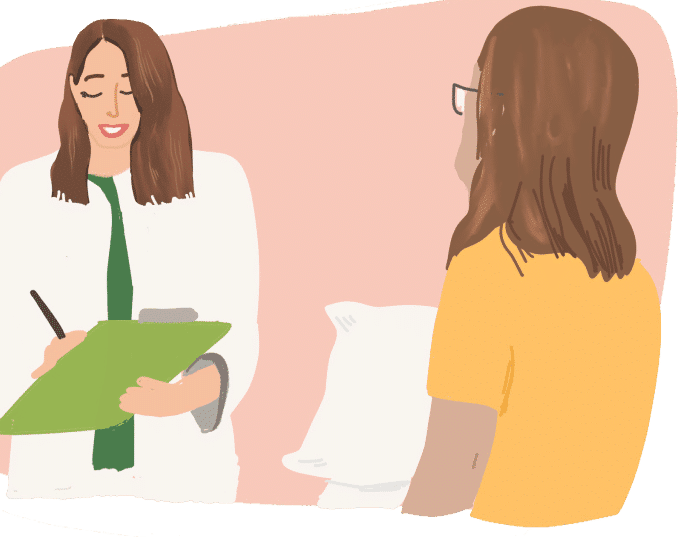

The pelvic floor and pelvic girdle muscles undergo significant changes during pregnancy and labor and delivery. Optimal pelvic health during pregnancy can help reduce musculoskeletal pain and dysfunction, ease labor and delivery, and help reduce postpartum complications. In 2018 the American College of Obstetrics and Gynecology issued a statement acknowledging that postpartum care in the United States needs to be improved, suggesting the term “4th Trimester” should be used for the immediate postpartum period and that postpartum women need more care than what is currently being offered. All pregnant and postpartum women can benefit from pelvic floor physical therapy given the crucial role these muscles play during delivery and how prevalent dysfunction is after birth. Pelvic floor physical therapy reduces the risk of pelvic organ prolapse, urinary, bowel, and sexual dysfunction and pelvic pain. Similar to other diagnoses we treat, many of our patients tell us they wish they knew about us sooner.
The Facts
- 71% of women are unaware that vaginal deliveries increase the risk of pelvic floor disorders
- Up to 70% of women experience stress urinary incontinence in the postpartum period
- 36% of women have persistent Diastasis Rectus Abdominis after delivery
- 51% of women can not perform a kegel with verbal cuing alone, 25% of women perform the exercise in a manner that promotes further dysfunction
- Up to 65% of women experience sexual dysfunction 18 months postpartum, regardless of the method of delivery
- 21% of women who undergo vaginal deliveries have Levator Ani Avulsion
- 29% of women undergoing vaginal deliveries have pubic bone fractures
- 77% of postpartum women have low back pain that interferes with daily tasks
- Vaginal deliveries are the number one risk for pelvic organ prolapse
The pelvic floor and pelvic girdle muscles undergo significant changes during pregnancy and labor and delivery. Optimal pelvic health during pregnancy can help reduce musculoskeletal pain and dysfunction, ease labor and delivery, and help reduce postpartum complications. In 2018 the American College of Obstetrics and Gynecology issued a statement acknowledging that postpartum care in the United States needs to be improved, suggesting the term “4th Trimester” should be used for the immediate postpartum period and that postpartum women need more care than what is currently being offered. All pregnant and postpartum women can benefit from pelvic floor physical therapy given the crucial role these muscles play during delivery and how prevalent dysfunction is after birth. Pelvic floor physical therapy reduces the risk of pelvic organ prolapse, urinary, bowel, and sexual dysfunction and pelvic pain. Similar to other diagnoses we treat, many of our patients tell us they wish they knew about us sooner.
The Facts
- 71% of women are unaware that vaginal deliveries increase the risk of pelvic floor disorders
- Up to 70% of women experience stress urinary incontinence in the postpartum period
- 36% of women have persistent Diastasis Rectus Abdominis after delivery
- 51% of women can not perform a kegel with verbal cuing alone, 25% of women perform the exercise in a manner that promotes further dysfunction
- Up to 65% of women experience sexual dysfunction 18 months postpartum, regardless of the method of delivery
- 21% of women who undergo vaginal deliveries have Levator Ani Avulsion
- 29% of women undergoing vaginal deliveries have pubic bone fractures
- 77% of postpartum women have low back pain that interferes with daily tasks
- Vaginal deliveries are the number one risk for pelvic organ prolapse
Pelvic Floor Physical Therapy During Pregnancy
Our bodies undergo significant changes as the pregnancy progresses. Many women experience symptoms that pelvic floor physical therapy can address.
- Constipation
- Urinary urgency, frequency, and leaking
- Pubic symphysis pain/separation
- Sacro-iliac joint, hip, and back pain
- Sciatic pain
Fortunately, some women tolerate pregnancy very well and experience no unwanted symptoms. For these women, pelvic floor physical therapy can help with the following:
- Optimize pelvic floor motor control to aid in labor and delivery
- Instruction in perineal massage to reduce perineal injuries
- Improve pelvic floor and pelvic girdle neuromuscular function to reduce pain and dysfunction in the postpartum period
- Education and support throughout the pregnancy and during the postpartum period

Pelvic Floor Physical Therapy During Pregnancy
Our bodies undergo significant changes as the pregnancy progresses. Many women experience symptoms that pelvic floor physical therapy can address.
- Constipation
- Urinary urgency, frequency, and leaking
- Pubic symphysis pain/separation
- Sacro-iliac joint, hip, and back pain
- Sciatic pain
Fortunately, some women tolerate pregnancy very well and experience no unwanted symptoms. For these women, pelvic floor physical therapy can help with the following:
- Optimize pelvic floor motor control to aid in labor and delivery
- Instruction in perineal massage to reduce perineal injuries
- Improve pelvic floor and pelvic girdle neuromuscular function to reduce pain and dysfunction in the postpartum period
- Education and support throughout the pregnancy and during the postpartum period

Postpartum Pelvic Floor Physical Therapy

All new moms should undergo an evaluation with a pelvic floor physical therapist. Ideally, this evaluation would take place in the first year following delivery; however, it is never too late to see a pelvic floor physical therapist. Postpartum pelvic floor physical therapy can help with:
- Urinary retention, urgency, frequency, hesitancy, pain and incontinence (leaking)
- Constipation, difficulty with bowel movement, fecal incontinence
- Painful sex, diminshed or absent orgasm
- Diastasis Rectus Abdominis
- Restoring core function and strength: abdominals and pelvic floor
- Pelvic floor and pelvic girdle, low back, and hip pain
- Cesarean section and episiotomy scar tissue and pain
- Pelvic organ prolapse prevention and/or treatment
- Eliminate pain from perineal and/or levator ani trauma
- Reduce pain from pelvic neuralgias
Postpartum Pelvic Floor Physical Therapy
All new moms should undergo an evaluation with a pelvic floor physical therapist. Ideally, this evaluation would take place in the first year following delivery; however, it is never too late to see a pelvic floor physical therapist. Postpartum pelvic floor physical therapy can help with:
- Urinary retention, urgency, frequency, hesitancy, pain and incontinence (leaking)
- Constipation, difficulty with bowel movement, fecal incontinence
- Painful sex, diminshed or absent orgasm
- Diastasis Rectus Abdominis
- Restoring core function and strength: abdominals and pelvic floor
- Pelvic floor and pelvic girdle, low back, and hip pain
- Cesarean section and episiotomy scar tissue and pain
- Pelvic organ prolapse prevention and/or treatment
- Eliminate pain from perineal and/or levator ani trauma
- Reduce pain from pelvic neuralgias

Treatment:
How We Can Help You

Prenatal and postnatal pelvic floor physical therapy begins with an evaluation with your physical therapist. During the evaluation, the physical therapist reviews your history with you, your current symptoms and functional challenges, and discusses your birth plan if you are prepartum and if postpartum, how your delivery went. Importantly, we understand the challenges of pregnancy and the postpartum period. During the physical examination the physical therapist examines muscles, tissues, joints, nerves, and movement patterns. Once your physical therapist completes the examination they review your findings with you. The physical therapist creates an assessment and short and long-term goals for your treatment plan. Typically, the frequency of physical therapy treatment is one time per week but this can vary greatly depending on the physical findings. You are given a home exercise program to compliment your in-person sessions, and your physical therapist will help to coordinate your recovery with your Obstetrician and the other members of your treatment team. We are here to help you recover and live your best life!

Treatment:
How We Can Help You
Prenatal and postnatal pelvic floor physical therapy begins with an evaluation with your physical therapist. During the evaluation, the physical therapist reviews your history with you, your current symptoms and functional challenges, and discusses your birth plan if you are prepartum and if postpartum, how your delivery went. Importantly, we understand the challenges of pregnancy and the postpartum period. During the physical examination the physical therapist examines muscles, tissues, joints, nerves, and movement patterns. Once your physical therapist completes the examination they review your findings with you. The physical therapist creates an assessment and short and long-term goals for your treatment plan. Typically, the frequency of physical therapy treatment is one time per week but this can vary greatly depending on the physical findings. You are given a home exercise program to compliment your in-person sessions, and your physical therapist will help to coordinate your recovery with your Obstetrician and the other members of your treatment team. We are here to help you recover and live your best life!
How Can We Help You?
Please use the form below to send us any questions or comments. You must include your e-mail address in order for us to send a response. Please be assured that all of your information will be kept confidential.

Join The Newsletter. Win a copy of our book, “Pelvic Pain Explained!”
We love getting to know our website visitors. Please tell us a little bit about yourself and get the latest info via PHRC e-newsletter!
*Subscribers automatically eligible to win our book, “Pelvic Pain Explained.”
At its heart, Pelvic Pain Explained is the story of how patients develop pelvic pain, the challenges patients and providers face throughout the diagnosis and treatment process, the difficult task of sifting through the different available treatment options, and the impact that an “invisible” condition has on a patient’s life and relationships, and much more.


